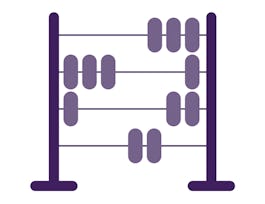This course introduces core areas of statistics that will be useful in business and for several MBA modules. It covers a variety of ways to present data, probability, and statistical estimation. You can test your understanding as you progress, while more advanced content is available if you want to push yourself.


Statistics for International Business
This course is part of International Business Essentials Specialization
Taught in English
Some content may not be translated

Instructor: George Kapetanios
14,372 already enrolled
Included with 
Course
(289 reviews)
81%
Details to know

Add to your LinkedIn profile
8 quizzes
Course
(289 reviews)
81%
See how employees at top companies are mastering in-demand skills

Build your subject-matter expertise
- Learn new concepts from industry experts
- Gain a foundational understanding of a subject or tool
- Develop job-relevant skills with hands-on projects
- Earn a shareable career certificate


Earn a career certificate
Add this credential to your LinkedIn profile, resume, or CV
Share it on social media and in your performance review

There are 4 modules in this course
In our study of statistics, we learn many methods to help us summarize, analyze, and interpret data with the aim of making informed decisions in an uncertain environment. In this first week we introduce tables and graphs that help us get a handle of data. These tools provide visual support for better decision making. With this in mind, we will guide you through the concept of decisions based on incomplete information. Beginning from here, we will introduce you to the concept of population vs. sample, of parameter vs. statistic and of descriptive statistics vs. inferential statistics. We will then go through the concept of describing data, and we will introduce the idea of creating and interpreting graphs to describe categorical and continuous random variables.
What's included
9 videos2 quizzes1 peer review
This week we will describe and summarize the information in the data using numerical values or measures that are able to summarise information. This is a crucial extension to the analysis of the previous week. While graphs are informative it is usually crucial for improved understanding of the data at hand to discuss their numerical properties. In this week, we will look at a range of measures, such as measures of central tendency, the range, variance, standard deviation, and so on.
What's included
10 videos2 quizzes
Probability theory is a young arrival in mathematics- and probability applied to practice is almost non-existent as a discipline. We should all understand probability, and this lecture will help you to do that. It’s important for you to understand first that the world in which your future occurs is not deterministic- and there are future outcomes where a probability model cannot be developed… This week, we will cover the basic definition of probability, the rules of probability,random variables, -probability density functions, expectations of a random variable and Bivariate random variables.
What's included
18 videos2 quizzes
For statistical analysis to work properly, it’s essential to have a proper sample, drawn from a population of items of interest that have measured characteristics. This week, we will cover statistical estimation, sampling distribution of the mean, point estimation, interval estimation, hypothesis testing, the Null hypothesis and look at some real life examples of their use.
What's included
22 videos4 readings2 quizzes1 peer review
Instructor

Offered by
Recommended if you're interested in Finance

University of London

University of London

University of London

University of London
Why people choose Coursera for their career




Learner reviews
Showing 3 of 289
289 reviews
- 5 stars
48.44%
- 4 stars
17.30%
- 3 stars
10.38%
- 2 stars
9.68%
- 1 star
14.18%
New to Finance? Start here.

Open new doors with Coursera Plus
Unlimited access to 7,000+ world-class courses, hands-on projects, and job-ready certificate programs - all included in your subscription
Advance your career with an online degree
Earn a degree from world-class universities - 100% online
Join over 3,400 global companies that choose Coursera for Business
Upskill your employees to excel in the digital economy
Frequently asked questions
Access to lectures and assignments depends on your type of enrollment. If you take a course in audit mode, you will be able to see most course materials for free. To access graded assignments and to earn a Certificate, you will need to purchase the Certificate experience, during or after your audit. If you don't see the audit option:
The course may not offer an audit option. You can try a Free Trial instead, or apply for Financial Aid.
The course may offer 'Full Course, No Certificate' instead. This option lets you see all course materials, submit required assessments, and get a final grade. This also means that you will not be able to purchase a Certificate experience.
When you enroll in the course, you get access to all of the courses in the Specialization, and you earn a certificate when you complete the work. Your electronic Certificate will be added to your Accomplishments page - from there, you can print your Certificate or add it to your LinkedIn profile. If you only want to read and view the course content, you can audit the course for free.
If you subscribed, you get a 7-day free trial during which you can cancel at no penalty. After that, we don’t give refunds, but you can cancel your subscription at any time. See our full refund policy.

